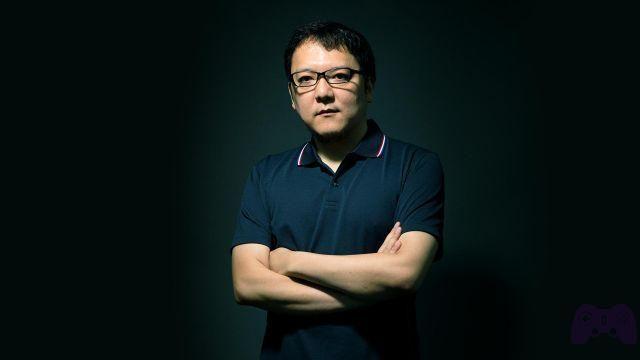
We gamers rarely find ourselves discussing the art of storytelling. A topic often considered secondary in a videogame work, subservient to fields much more relevant to the media such as graphics and gameplay. There history which is the background to our virtual exploits, it is often served under our noses on large glass jars, from which we are promptly fed like hungry babies through long cinematic and full-bodied dialogues. We do not dwell much on the presentation of the dish, we are not so refined, we just need to have the baby food of excellent quality. This kind of narrative exhibition, which even in its most extreme form has nevertheless led to genre masterpieces, is the daughter of more and more blurred boundary between cinema and video game, which over the years has caused a massive invasion of child elements of the seventh art. This "cinephilization" would certainly have conquered the entire play medium, if a small group of game designers and storytellers had not realized that the video game offered narrative possibilities unthinkable for the world of cinema. One of these was certainly Hidetaka Miyazaki.
A narrative born of a childhood necessity ...
The personality of the Japanese game director has moved areas from the game critic that had long been dormant. There meticulous care that he pours on the design and gameplay of his works is now widely recognized (net of the various technical problems that often plague FromSoftware titles), but the peculiar narrative method which it has adopted since the legendary Demon's Souls, has not received the same unanimous approval. In an interview with The Guardian in 2015, Miyazaki revealed that his particular style of storytelling matured in him from an early age. During the'childhood, little Hidetaka grew up in a very poor family on the outskirts of Shizukoka, a town southwest of Tokyo. Even then he was an avid reader, but not being able to afford the books and manga he wanted, he had to be content with what the public library offered. The books he was able to recover were not always suitable for his age so, through the images he found between the pages, he tried with his imagination to imagine what his age did not allow him to understand.
Our lore of lore
This article stems from a thriving discussion of Miyazaki's narrative style in the Holygamerz Telegram group. If you feel like joining the rebellion join us here.
And it is precisely from that effort of imagination, from not being satisfied with only understanding what was on the surface, that the so-called souls-like were born, which more for the arduous gameplay and the ingenious level design, found their raison d'etre right on a dark and sipped plot. But is the much-vaunted “soulian” lore, with which we often fill our mouths, really so accurate? There are many who argue that the particular narrative device devised by Miyazaki only serves to disguise one general artistic deficiency by FromSoftware. Indeed, at the very first glance, one is led to judge a Miyazaki title as one indie production which has staked everything on 3D models. Coming from Rockstar or EA products, you are thrilled to observe NPCs always motionless, who do not even move their lips when they speak to you. No breathtaking cinematics, no AI to give a semblance of a life of its own, no defined mission to follow. Nothing. It's just you with your greatsword and a horde of insane creatures to slaughter. It is evident that seen from this point of view, FromSoftware's works can only have an equally lacking plot and that Miyazaki's true genius was to create a method of sorytelling that justifies these technical shortcomings as part of the plot. But is it really so? Did Miyazaki really create a unique ad hoc storytelling method to obscure FromSoftware's gaps? Let's try to analyze it together.

Environmental storytelling: the environment speaks to us
An art of storytelling almost as old as storytelling itself ...
THEenvironmental storytelling, or environmental narrative, is a technique that allows the narrator to tell part of the story in indirect way through the environment. A building built with a particular architectural style, a corpse adorned with a singular banner, halls adorned with statues of an ancient order of knights. This is the environment that tells us its story, which allows us to assimilate information by osmosis, even if most of the time we don't notice it. Obviously this type of storytelling it is not exploitable in any media, it is necessary to be able to observe closely and calmly the environment that makes up the scene. Video games certainly lend themselves well to this type of storytelling, but we don't think for a moment that they were the first to exploit it, because it it is almost as old as the narrative itself. For millennia we have told stories through painting, hidden small sensitive messages against the backdrop of large frescoes, built immense architectures dedicated to the gods and their history. The Mona Lisa by Leonardo da Vinci is a striking example: the painting itself is very small and considered technically inferior to other works by the Maestro, but hides a set of messages and symbolisms, scattered throughout the painting, which have fascinated generations and generations of critics.
"A well-designed world could tell its story in silence."
Hidetaka Miyazaki
To learn more:
The legacy of Dark Souls
Miyazaki in his titles has used this ancient technique extensively, disseminating clues about the lore in every area of the game. The “Miyazakh” environmental storytelling emblem is the Fortress of Sen. It is very difficult during the first run of the game to appreciate the subtleties of texture which are hidden there due to its difficulty, but if you carefully observe the enemies that you encounter there, the statues that adorn it and the strategic position in which it is located, you will discover many details about its history and that of the entire Lordran . Given its position, i.e. in an area prior to Anor Londo, and the presence of numerous pitfalls, it is evident that it was built by the gods to try the chosen undead. To confirm all this is the presence of giants guarding the fortress, who, between a trap and a fight at the last perry, allow only the most worthy to enter the city so longed for. But what makes this place fascinating, enriching it with unwritten lore, is the presence of many other enemies. First i undead knights, which represent the countless chosen ones who were not able to walk that arduous path (symbol of cyclicality so dear to Miyazaki). The snake men, sent by Seath the Scaleless to prevent anyone from entering his Duke Archives, an area bordering Anor Londo. And finally i demons of tinanite, symbol of a world now in ruins populated by uncontrollable demons, who have become so reckless as to reach the threshold of their most bitter enemy. For hours we could discuss the countless examples of environmental storytelling adopted by the game director of FromSoftware in each of his titles. Although it has been a widely used technique in the history of storytelling, Miyazaki has been able to use it wisely taking it to its extreme. Others would have dismissed it all with a pompous kinametic.
The emblem of Miyazakh environmental storytelling is the Sen Fortress
Minimalist storytelling: the art of narrative ellipses
Tom Bombadil
One of the most enigmatic characters in The Lord of the Rings is surely Tom Bombadil. He is the protagonist of several chapters in The Fellowship of the Ring, where he repeatedly saves the four hobbits on their way to Bree.
Along with environmental narrative, Miyazaki uses another narrative technique, which, perhaps most of all, has generated debate and criticism from the public. Let's talk about his minimalist storytelling, the art of telling as little as possible, leaving out the superfluous. In the souls you will never find ancient scrolls to read or long theatrical dialogues, everything, from the description of the objects to the few interactions with the characters, is savored. An integral part of this technique are the narrative ellipses, which, like environmental storytelling, have their origin in much older arts than video games. A fervent user and supporter of the latter was John RR Tolkien. Despite his legendary precision in creating a consistent world and history (so much so that he invented a language from nothing with an alphabet and grammar), he scattered here and there in his story what seem to all intents and purposes weft holes. History events only mentioned and never resumed, well-characterized characters who appear only for a few chapters. A method that seems to clash with the sometimes maniacal care that the master of fantasy poured into his works, but which it finds its raison d'etre in the stories so full of history. Creating events or characters that are not well defined, citing them and then forgetting them, lights up one in the reader morbid curiosity but above all, if it is not satisfied, its own fantasy. This makes the reader an active part and no longer a passive one, who is pushed to inquire and formulate hypotheses and speculations.
“From the point of view of history, I think it is better that some things remain unexplained (especially if an explanation actually exists). And even in a mythical age there must be some enigma, as there always is. Tom Bombadil is an (intentional) example of this. "
John RR Tolikien, Letter no. 174
To learn more:
The emptiness of Hidetaka Miyazaki and Fumito Ueda
Evident narrative ellipsis is the story of Stealth Dwarf in the first Dark Souls. Along with Gwyn, Nito and Izalith, the Stealth Dwarf was one of the four lords who recovered a Soul of the Lords from the First Flame. He was different from all the others, inferior in both stature and power, but the soul he found in the flames was certainly the most important of all: the Dark Soul, the Dark Soul from which the game takes its name, bearer of humanity. The more it divided, the more powerful it became, thus giving birth to the race of men. After its first appearance during the initial kinematics, nothing more will be known for sure about the Stealth Dwarf. The Primordial Serpent will be mentioned by Kaathe, who will reveal to the player his true nature, which is to be his descendant. Then nothing more, some small allusion scattered here and there, but nothing that allows the "reader" to reconstruct one certain storyline about this incredible character.
Examples of narrative ellipses can be found in all souls, from the figure of Blood Minister in Bloodborne, to the true nature of Sopite flames in Dark Souls III, but that of the Stealth Dwarf is certainly the most emblematic as it is the most extreme. A character so important for the game's plot that he is voluntarily left out, is synonymous with how Miyazaki wanted to revisit and take to extremes techniques already widely exploited, taking them to the next level.

Collective storytelling: a new way of telling

To learn more:
Storytelling and Open World: two conflicting universes?
Finally, we come to the technique probably most exploited by Miyazaki, which certainly made FromSoftware's fortune. Direct consequence of the first two, the collective storytelling he gathers the hard-sown fruits to passively observe his own work "Go about your business", quoting Umberto Eco. Yes, because the story of Boletaria, Lordran, Drangleic, Yharnam and Lothric are the result of a collective work, of the passion that we all have for these incredible worlds so mysterious and therefore so fascinating. Miyazaki is well aware of the power of this art, especially inera of social media. Forums, pages, articles and Youtube channels have proliferated like mushrooms in Oolacile, to talk about plot and speculation. Much over time has been deduced thanks to cross-user studies and today it is almost possible to read the souls plot like any other. It is likely that it was only the right timing to generate all this noise, but it is undeniable that never before the souls a niche phenomenon, like Demon's Souls was, has become so mainstream while remaining true to its original nature.
A niche phenomenon that has become mainstream, but true to its original nature
So, taking up the question posed at the beginning of this spoloquio, did Miyazaki really create an ad hoc narrative to obscure FromSoftware's gaps? As we were able to analyze together, Miyazaki did not invent anything, but he definitely managed to exploit the hidden potential of the video game, using techniques unusual for the medium. And that's not cheap at all. In a historical period where more and more authorship is being supplanted by lootbox and season pass, knowing that there are still AAA productions so free to experiment, to carry on your message regardless of the crowd, it's really reassuring. But if you are still not convinced that Hidetaka Miyazaki is one of the few authors who still manage to elevate the gaming world to the state of the art, listen to the melody below. From the first notes, you will immediately understand that only a great author could combine such calm and melancholy music with such a fierce battle: the last battle against the Lord of the Embers.






